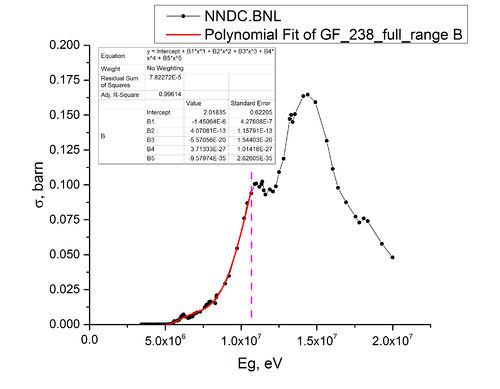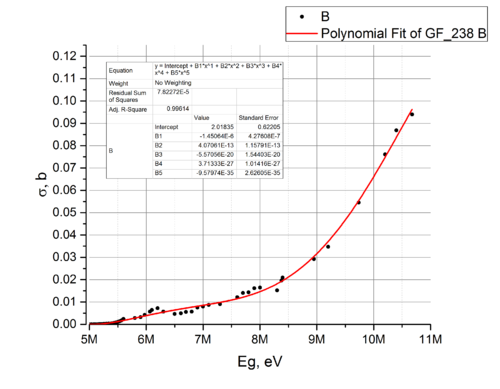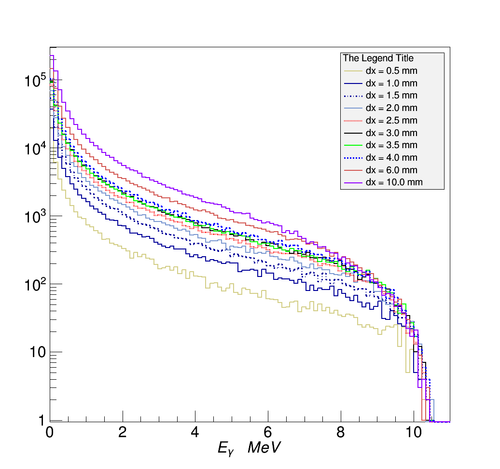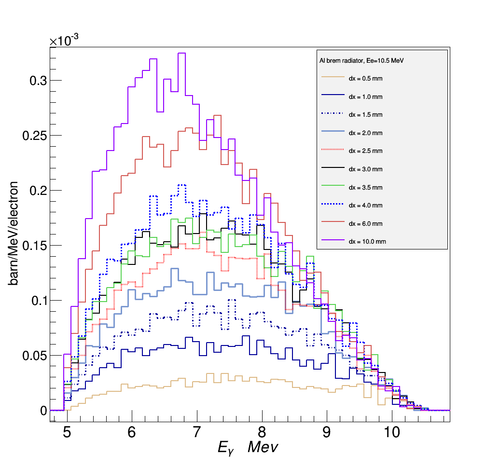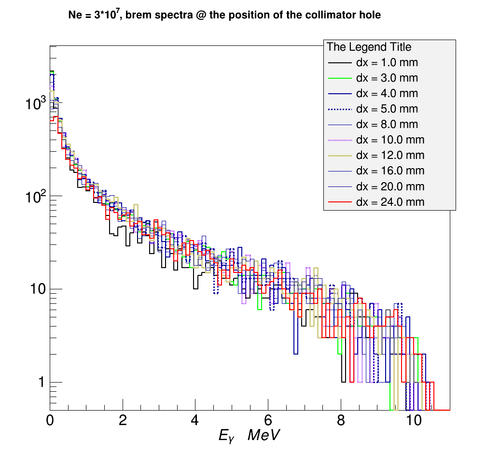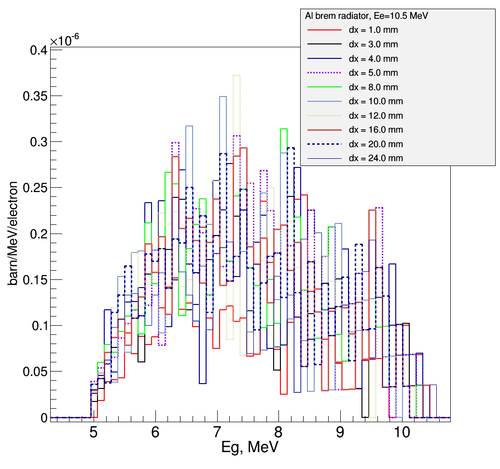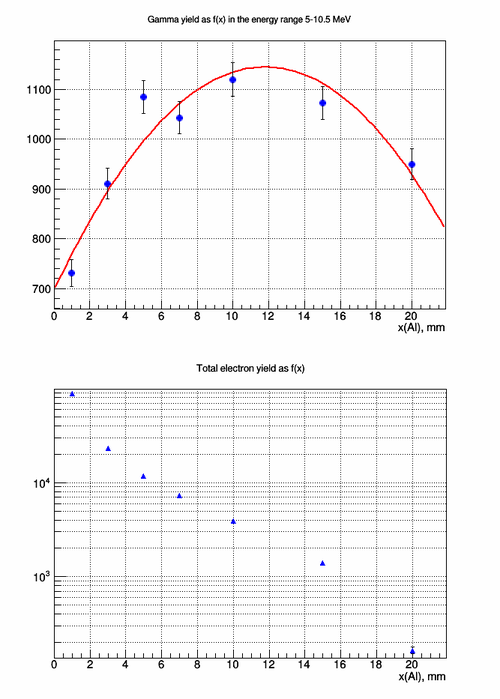Difference between revisions of "Brem converter optimization"
| (45 intermediate revisions by the same user not shown) | |||
| Line 1: | Line 1: | ||
| − | The optimization of the photon yield from Al bremsstrahlung converter to get the maximum <math>(\gamma,f)</math> reaction rate in the case of U-238 target was simulated using Geant4 for the incident electrons with the energy E = 10.5 MeV | + | The optimization of the photon yield from Al bremsstrahlung converter to get the maximum <math>(\gamma,f)</math> reaction rate in the case of U-238 target was simulated using Geant4 for the incident electrons with the energy E = 10.5 MeV. The electron beam had no divergence. The only physics used in the simulation was ''G4EmStandardPhysics'' electromagnetic physics. |
| Line 12: | Line 12: | ||
The photon yield as a function of the photon energy simulated for different bremsstrahlung converter lengths is provided below. In each case of the converter length the number of the incident electrons was equal to <math>10^6</math>. No collimation cuts were applied. | The photon yield as a function of the photon energy simulated for different bremsstrahlung converter lengths is provided below. In each case of the converter length the number of the incident electrons was equal to <math>10^6</math>. No collimation cuts were applied. | ||
| − | [[File: | + | [[File:Total_gamma_yield_Al_dx_2.png | 500 px]] |
After the normalization of the total yield to the number of incident electrons and photon energy, and weighting the yield by the U-238 <math>(\gamma,f)</math> cross section, the following photon yield was obtained (no collimation cuts were applied) : | After the normalization of the total yield to the number of incident electrons and photon energy, and weighting the yield by the U-238 <math>(\gamma,f)</math> cross section, the following photon yield was obtained (no collimation cuts were applied) : | ||
| − | [[File: | + | [[File:Weighted_gamma_yield_Al_dx_2.png | 500 px]] |
| − | As can be seen for the given U-238 target the highest reaction <math>(\gamma,f)</math> rate would be for the case of | + | As can be seen for the given U-238 target the highest reaction <math>(\gamma,f)</math> rate would be for the case of 10 mm Al radiator, assuming that all the photons composing the above distribution reach the target. |
| + | |||
| + | Now the collimation effect was taken into account. The collimator was placed 63 cm down the bremsstrahlung converter and had a diameter of 0.25". Bremsstrahlung converter had a shape of a disk with variable thickness and the diameter of 5.5 cm. Total number of the incident electrons was <math>3*10^7</math>. The number of photons produced in the radiator and reached the collimator (Ng_tot) was counted. The value of a signal (Sig) is the number of photons in the range of energies [5,10.5] MeV. The value of a background (BKG) is the number of photons in the range of energies [0,5) MeV. | ||
| + | |||
| + | [[File:Total_gamma_yield_Al_dx_coll.png | 500 px]] | ||
| + | |||
| + | [[File:BKG_gamma_yield_Al_dx_coll.png | 500 px]] | ||
| + | |||
| + | Weighted part of the bremsstrahlung spectra that will cause <math>(\gamma,f)</math> reaction of U-238 element: | ||
| + | |||
| + | [[File:Weighted_gamma_yield_Al_dx_coll_2.png | 500 px]] | ||
| + | |||
| + | {| class="wikitable" border="1" | ||
| + | ! style="text-align: center;" | l, mm | ||
| + | ! style="text-align: center;" | Ng_tot | ||
| + | ! style="text-align: center;" | Sig, [5,10.5] MeV | ||
| + | ! style="text-align: center;" | BKG, [0,5) MeV | ||
| + | ! style="text-align: center;" | BKG*, [1,5) MeV | ||
| + | ! style="text-align: center;" | Sig/BKG | ||
| + | ! style="text-align: center;" | Sig/BKG* | ||
| + | ! style="text-align: center;" | A(<math>\mu</math>barn/MeV/electron), U-238 <math>(\gamma,f)</math> | ||
| + | |- | ||
| + | | style="text-align: center;" | 1 | ||
| + | | style="text-align: center;" | 6319 | ||
| + | | style="text-align: center;" | 293 | ||
| + | | style="text-align: center;" | 6026 | ||
| + | | style="text-align: center;" | 1339 | ||
| + | | style="text-align: center;" | 0.0486 | ||
| + | | style="text-align: center;" | 0.219 | ||
| + | | style="text-align: center;" | 4.6 | ||
| + | |- | ||
| + | | style="text-align: center;" | 3 | ||
| + | | style="text-align: center;" | 7538 | ||
| + | | style="text-align: center;" | 380 | ||
| + | | style="text-align: center;" | 7158 | ||
| + | | style="text-align: center;" | 1778 | ||
| + | | style="text-align: center;" | 0.0531 | ||
| + | | style="text-align: center;" | 0.214 | ||
| + | | style="text-align: center;" | 6.4 | ||
| + | |- | ||
| + | | style="text-align: center;" | 4 | ||
| + | | style="text-align: center;" | 7450 | ||
| + | | style="text-align: center;" | 409 | ||
| + | | style="text-align: center;" | 7041 | ||
| + | | style="text-align: center;" | 1801 | ||
| + | | style="text-align: center;" | 0.0581 | ||
| + | | style="text-align: center;" | 0.227 | ||
| + | | style="text-align: center;" | 6.6 | ||
| + | |- | ||
| + | ! style="text-align: center;" | 5 | ||
| + | ! style="text-align: center;" | 7726 | ||
| + | ! style="text-align: center;" | 414 | ||
| + | ! style="text-align: center;" | 7312 | ||
| + | ! style="text-align: center;" | 1865 | ||
| + | ! style="text-align: center;" | 0.0566 | ||
| + | ! style="text-align: center;" | 0.222 | ||
| + | ! style="text-align: center;" | 7.0 | ||
| + | |- | ||
| + | | style="text-align: center;" | 8 | ||
| + | | style="text-align: center;" | 7510 | ||
| + | | style="text-align: center;" | 412 | ||
| + | | style="text-align: center;" | 7098 | ||
| + | | style="text-align: center;" | 1989 | ||
| + | | style="text-align: center;" | 0.0580 | ||
| + | | style="text-align: center;" | 0.207 | ||
| + | | style="text-align: center;" | 6.6 | ||
| + | |- | ||
| + | | style="text-align: center;" | 10 | ||
| + | | style="text-align: center;" | 7179 | ||
| + | | style="text-align: center;" | 406 | ||
| + | | style="text-align: center;" | 6773 | ||
| + | | style="text-align: center;" | 1934 | ||
| + | | style="text-align: center;" | 0.0599 | ||
| + | | style="text-align: center;" | 0.210 | ||
| + | | style="text-align: center;" | 6.5 | ||
| + | |- | ||
| + | | style="text-align: center;" | 12 | ||
| + | | style="text-align: center;" | 6954 | ||
| + | | style="text-align: center;" | 416 | ||
| + | | style="text-align: center;" | 6538 | ||
| + | | style="text-align: center;" | 1889 | ||
| + | | style="text-align: center;" | 0.0636 | ||
| + | | style="text-align: center;" | 0.220 | ||
| + | | style="text-align: center;" | 6.7 | ||
| + | |- | ||
| + | | style="text-align: center;" | 16 | ||
| + | | style="text-align: center;" | 6333 | ||
| + | | style="text-align: center;" | 400 | ||
| + | | style="text-align: center;" | 5933 | ||
| + | | style="text-align: center;" | 1846 | ||
| + | | style="text-align: center;" | 0.0674 | ||
| + | | style="text-align: center;" | 0.217 | ||
| + | | style="text-align: center;" | 6.5 | ||
| + | |- | ||
| + | | style="text-align: center;" | 20 | ||
| + | | style="text-align: center;" | 5756 | ||
| + | | style="text-align: center;" | 412 | ||
| + | | style="text-align: center;" | 5344 | ||
| + | | style="text-align: center;" | 1777 | ||
| + | | style="text-align: center;" | 0.0771 | ||
| + | | style="text-align: center;" | 0.232 | ||
| + | | style="text-align: center;" | 6.6 | ||
| + | |- | ||
| + | | style="text-align: center;" | 24 | ||
| + | | style="text-align: center;" | 5143 | ||
| + | | style="text-align: center;" | 377 | ||
| + | | style="text-align: center;" | 4766 | ||
| + | | style="text-align: center;" | 1673 | ||
| + | | style="text-align: center;" | 0.0791 | ||
| + | | style="text-align: center;" | 0.225 | ||
| + | | style="text-align: center;" | 6.2 | ||
| + | |} | ||
| + | |||
| + | |||
| + | ---- | ||
| + | The distance between Al bremsstrahlung converter and the collimator is 7 ft, the diameter of the collimator 0.25" and its length is 10 cm. Photons and electrons were observed behind the collimator. Surrounding is vacuum. The collimator absorbs everything that hits it. The total number of incident electrons was <math>10^{9}</math>. | ||
| + | |||
| + | [[File:brem_conv_opt.png |500 px]] | ||
Latest revision as of 15:39, 13 February 2015
The optimization of the photon yield from Al bremsstrahlung converter to get the maximum reaction rate in the case of U-238 target was simulated using Geant4 for the incident electrons with the energy E = 10.5 MeV. The electron beam had no divergence. The only physics used in the simulation was G4EmStandardPhysics electromagnetic physics.
The total cross section for U-238 target was taken fron nndc/BNL web site and provided below:
Since the electron energy is 10.5 MeV the photons will have maximum energy of 10.5 MeV. The information on the photofission cross section was obtained for the photon energies in the range of [5-10.5] MeV using polynomial fit and presented below for the magnified region of the U-238 cross section vs photon energy plot:
The photon yield as a function of the photon energy simulated for different bremsstrahlung converter lengths is provided below. In each case of the converter length the number of the incident electrons was equal to . No collimation cuts were applied.
After the normalization of the total yield to the number of incident electrons and photon energy, and weighting the yield by the U-238 cross section, the following photon yield was obtained (no collimation cuts were applied) :
As can be seen for the given U-238 target the highest reaction rate would be for the case of 10 mm Al radiator, assuming that all the photons composing the above distribution reach the target.
Now the collimation effect was taken into account. The collimator was placed 63 cm down the bremsstrahlung converter and had a diameter of 0.25". Bremsstrahlung converter had a shape of a disk with variable thickness and the diameter of 5.5 cm. Total number of the incident electrons was . The number of photons produced in the radiator and reached the collimator (Ng_tot) was counted. The value of a signal (Sig) is the number of photons in the range of energies [5,10.5] MeV. The value of a background (BKG) is the number of photons in the range of energies [0,5) MeV.
Weighted part of the bremsstrahlung spectra that will cause reaction of U-238 element:
| l, mm | Ng_tot | Sig, [5,10.5] MeV | BKG, [0,5) MeV | BKG*, [1,5) MeV | Sig/BKG | Sig/BKG* | A(barn/MeV/electron), U-238 |
|---|---|---|---|---|---|---|---|
| 1 | 6319 | 293 | 6026 | 1339 | 0.0486 | 0.219 | 4.6 |
| 3 | 7538 | 380 | 7158 | 1778 | 0.0531 | 0.214 | 6.4 |
| 4 | 7450 | 409 | 7041 | 1801 | 0.0581 | 0.227 | 6.6 |
| 5 | 7726 | 414 | 7312 | 1865 | 0.0566 | 0.222 | 7.0 |
| 8 | 7510 | 412 | 7098 | 1989 | 0.0580 | 0.207 | 6.6 |
| 10 | 7179 | 406 | 6773 | 1934 | 0.0599 | 0.210 | 6.5 |
| 12 | 6954 | 416 | 6538 | 1889 | 0.0636 | 0.220 | 6.7 |
| 16 | 6333 | 400 | 5933 | 1846 | 0.0674 | 0.217 | 6.5 |
| 20 | 5756 | 412 | 5344 | 1777 | 0.0771 | 0.232 | 6.6 |
| 24 | 5143 | 377 | 4766 | 1673 | 0.0791 | 0.225 | 6.2 |
The distance between Al bremsstrahlung converter and the collimator is 7 ft, the diameter of the collimator 0.25" and its length is 10 cm. Photons and electrons were observed behind the collimator. Surrounding is vacuum. The collimator absorbs everything that hits it. The total number of incident electrons was .
